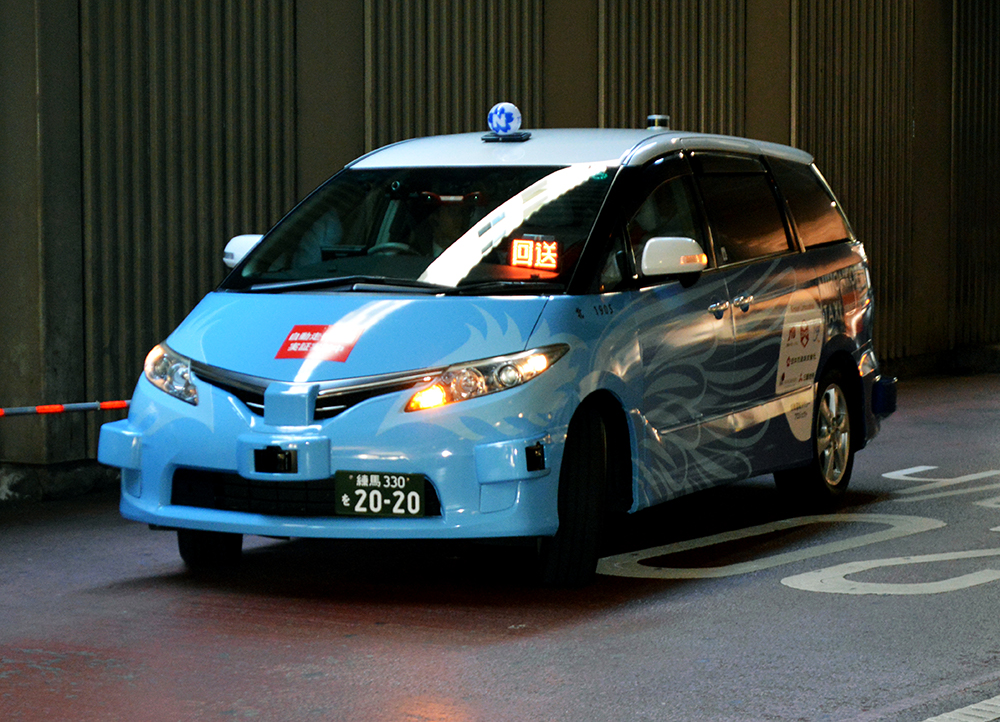I was lingering at a taxi stand in Tokyo’s Ningyocho district, actively trying to temper my expectations, when a bright blue car, the flexed white wings of a bird splashed across its body, slowly rolled up in front of me.
It looked more like a cartoon prop than the future of consumer transport, but I didn’t want to be a victim of first impressions. The door of the taxi opened, and I stepped inside.
A jumble of wires hung from the roof like banyan tree vines. Screens mapping out my surroundings using various arcane technologies were fixed to the back of every seat. A driver sat behind the wheel, but evidently not a robotic one.
Taking a Driverless Ride
I was embarking on the inaugural MaaS (Mobility as a Service) autonomous taxi service demonstration; the brainchild of ZMP, a Japan-based robotics company. Their roll out of this, still embryonic, technology gained financial supported from the Tokyo Metropolitan Government.
As the issue of taxi driver shortages faces the Japanese capital, while the nation is in the thrall of an unprecedented tourism boom (10 million foreign visitors are set to descend upon Tokyo for the 2020 Olympics alone), the need for transport infrastructure innovation is greater than ever.
TMG stated in a June 2019 press release: “Autonomous driving technology has great significance [for] Japan’s growth strategy and has the potential to solve social issues facing Tokyo.”

Photo by Kyriacos Anastasiou
Not Quite ‘Tokyo Drift’
Hollywood has warped the reality of self-driving cars for most of us. We’ve been inundated with fantasies about super-powered, artificially intelligent vehicles from Knight Rider to Transformers to Pixar’s Cars.
ZMP’s first outing on the streets had huge boots to fill. This particular demo felt a long way from those flimsy movie-induced pipe dreams, but left me with hope that there may be some legs in the technology if given adequate time to gestate.
On entering the car, the touchscreen in front of me offered some prompts: Seatbelt on? Route okay? Ready to go? Technology often has its ways of making me feel inferior, or at the very least lacking in basic mental faculties, so the screen’s unresponsiveness to my finger taps felt somewhat inevitable.
The taxi terminal staff fussed over the screen, uttering some confused grumbles, before it finally kicked into gear, and the car hesitantly chugged off to a stuttering start.
Driving the Future
As we traversed the busy midday streets toward our destination in Marunouchi, my initial cynicism started to wane. After all, I was in a car that was propelling itself forward.
Elon Musk may have been harping on evangelically about self-driving cars for the past few years, but until I’d actually experienced a car voluntarily change lanes, adjust its speed and avoid the dynamic obstacles of Tokyo’s urban streets, it was hard to appreciate what a marvel it is.
Just watching it in motion was bizarrely transfixing
While the car was in motion a screen to my right utilized some form of projection mapping technology. The sensory data displayed on the black background represented other cars as blue blocks, lanes and buildings as shifting yellow lines, and the taxi as a central green rectangle.
Just watching it in motion was bizarrely transfixing. It looked like a defunct Windows 98 screensaver, but witnessing in real time the car’s “awareness” of its current surroundings was highly impressive.
Speed Bumps
Admittedly, the drive was not without its hitches. The taxi broke more suddenly than I’d have bargained for on occasion. More than once it seemed the driver intervened before we re-shaped parked vehicles along the roadside.
I’m sure we would have made roadkill of some idling salarymen as we swung through Nihombashi had the driver not, once again, been dutifully on hand. But the reality is that this ZMP demo was a proof of concept, and far from the finished article.
About 15 to 20 minutes after departure, I arrived in Marunouchi unscathed and in two minds about the current state of self-driving vehicles. The key word in the narrative is “future.” If the technology is iterated upon, ironing out the creases and improving consistency, it may start to look more like a sustainable model for mass consumer transport.
For now, there are still too many questions. Can I trust the car not to send me careening off a cliff face? Is it going to make me an accessory to a hit and run rampage? Or quite simply, is it actually cheaper or safer than just driving myself? Frankly, it may be quite some time before we get the answers, but Rome wasn’t built in a day.
A proposed release date for Tokyo’s new autonomous taxi service has yet to be announced.








